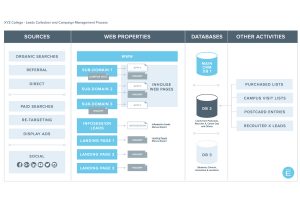
In recent years, digital marketing has exploded with rapidly changing landscape and technology making tracking and analytics a challenge.


In recent years, digital marketing has exploded with rapidly changing landscape and technology making tracking and analytics a challenge.

Businesses spend money on marketing channels to attract right-fit prospects and take a desired action on their website, e.g. make a purchase, request information, download a pdf, sign-up for newsletter, etc… Each of these actions when completed is counted as a ‘goal’. However, most visitors to the website find their way to the goal after […]

When launching a new marketing campaign, especially in Higher Education, tracking code and tag placement on websites, landing pages, blogs, emails and all pieces of the campaign are critical to evaluating campaign effectiveness and success. The process to set up and test this can be very time consuming and challenging. Coordination with the client marketing […]

Visitors to a website can come multiple times using any combination of direct, online search, ads, emails, etc. as sources before they convert. In previous versions of Google Analytics reports only the last touch point for a conversion was reported on. With the introduction of multi-channel funnel (MCF) reports, prior touch points which led to […]

Landing pages and vanity websites are an integral part of digital marketing. These are mostly single HTML pages and come in a variety of flavors from simple text to more complex media rich pages. The latter may contain any combinations of image & video galleries, flash-driven elements, download resources, ajax elements, gadgets etc. Visitors interact […]

Email is one of the most widely used digital marketing tools in the communications landscape, and every email marketing platforms has built-in tracking to report on metrics such as email delivery, bounce, open, click-thru and un-subscribe rates etc. However, this integrated email tracking systems can’t provide insight on activities and behaviors of email referrers on […]

Comparing last four months of pre-launch and post-launch analytics data of recently launched responsive website for a client, revealed some interesting insights. Website traffic remained unchanged Share of Mobile traffic increased Share of Direct traffic increased Shift in Desktop traffic to Mobile Overall, for the new website, traffic visit numbers remained relatively unchanged. However, the […]

In our experience, measurement, collection and reporting of website data are usually not a well-defined piece of a marketing plan for many businesses. One such area where marketers often struggle with Google Analytics (GA) reports is related to campaign attribution. Due to technicalities and nature of the internet, it is not straightforward to know the […]

Although marketing creativity is a right-brain activity, in today’s digital realm marketers are also responsible for the left-brain activity of measuring, analyzing and reporting on the effectiveness of their marketing programs. One of the most common web traffic measurement techniques involves…